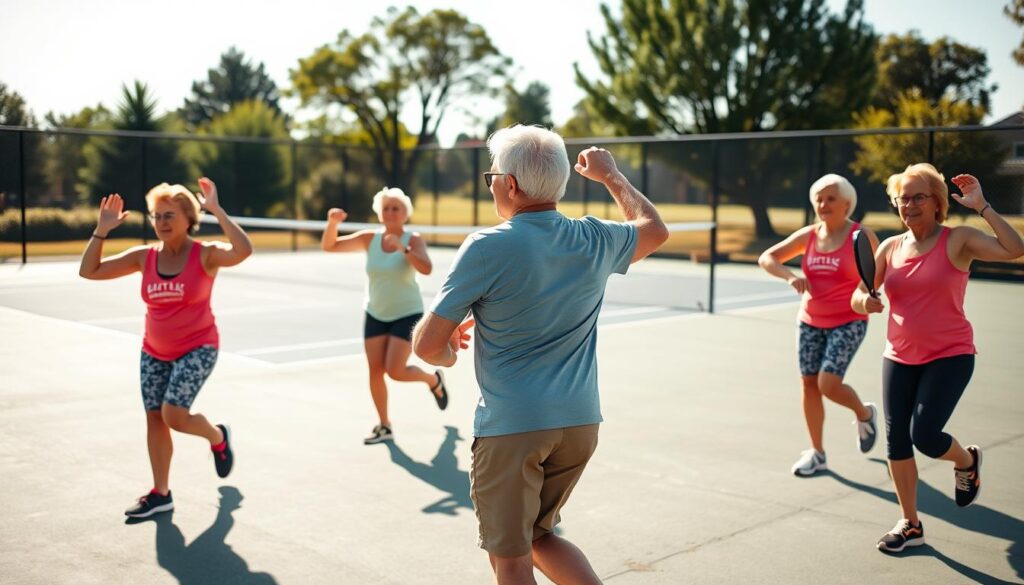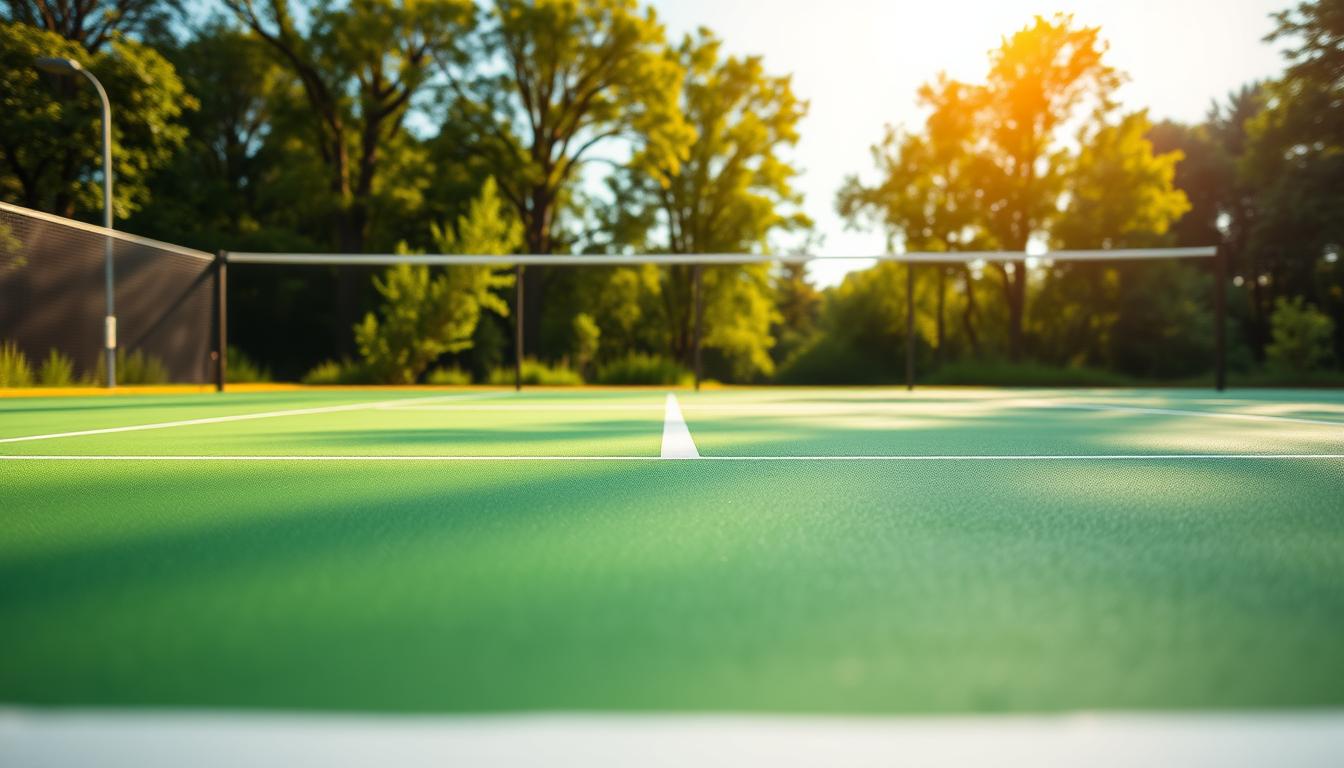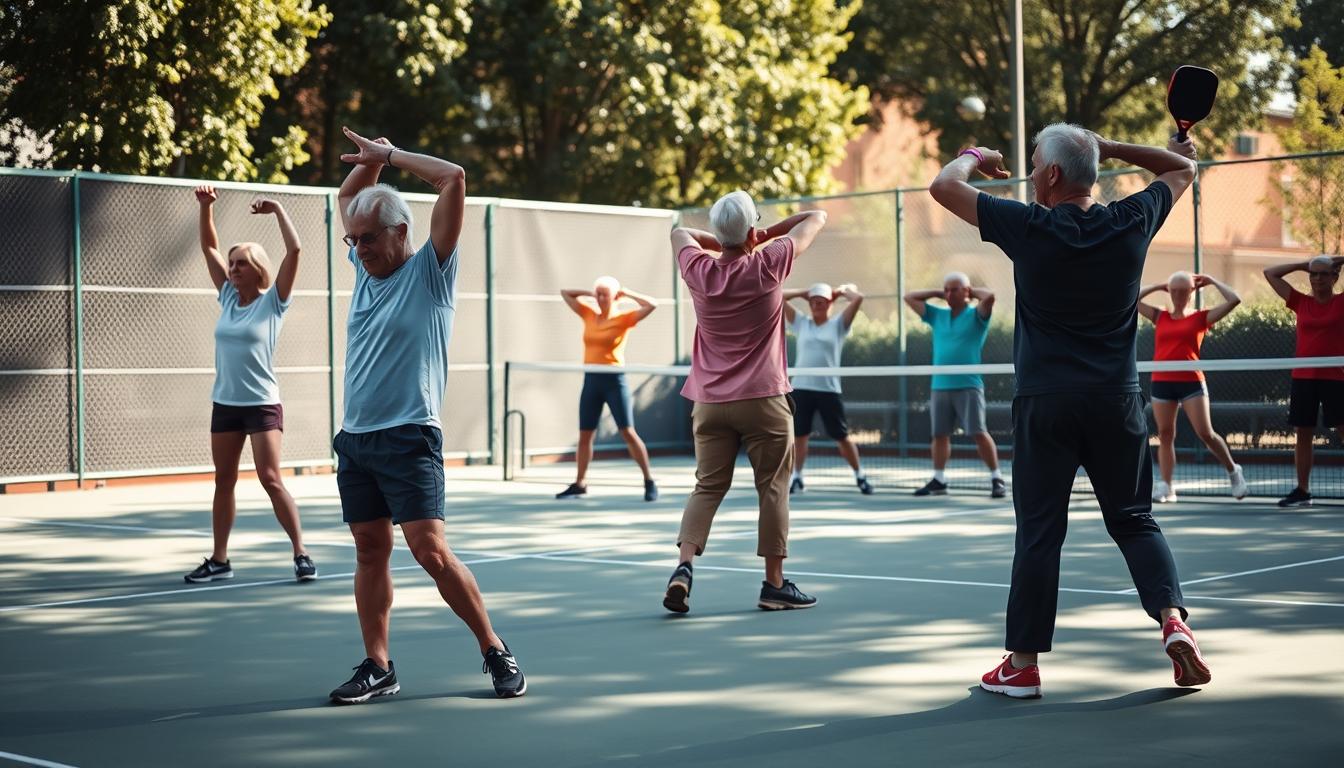Curious: can a focused few minutes before play cut injury risk and boost on-court performance?
This short guide gives a practical, step-by-step routine for adults over 50 who love the sport. It shows how to prepare upper body, lower body, and core with movements that match real game demands.
Start with a 5–10 minute general session to raise circulation and core temperature. Then move to dynamic drills like forward lunges with rotation, lateral lunges, inchworms, leg swings, and arm circles. These drill the muscles for forward, backward, side-to-side, and rotational action.
The focus is gentle intensity, joint prep, and consistent movement patterns so you accelerate and decelerate safely on the court. The full flow will fit into minutes you already spend arriving, making it realistic for league days or casual play.
Why Warming Up Matters for Senior Pickleball Players
Raising core temperature and circulation first helps your body respond faster on the court.
A short, progressive routine improves flexibility and mobility. It increases blood flow to muscles and joints and reduces stiffness that slows down movement.

Gradually increasing heart rate and blood flow lets the body move freely during rallies. When synovial fluid circulates, joints feel better for split-steps and quick changes of direction.
- An intentional ramp-up reduces sudden stress and helps muscles fire in sequence for smoother actions.
- Common problem areas include the lower back from rotation, elbow and knee tendons from repetitive shots, and hips, hamstrings, or groin from start-stop footwork.
- Good preparation leads to a quicker first step, better paddle preparation, and fewer late, off-balance contacts.
- Even a brief routine signals the nervous system to coordinate movements more precisely, improving timing and touch.
| Benefit | How it helps | On-court result |
|---|---|---|
| Increased circulation | Warms muscles and joints | Faster lateral movement |
| Joint lubrication | Boosts synovial fluid flow | Smoother split-steps |
| Neuromuscular priming | Improves muscle firing order | Better timing and accuracy |
Five-Minute General Warm-Up to Raise Heart Rate Before You Hit the Court
A brisk five-minute start gets blood moving and prepares joints for court actions.
This short sequence gently elevates heart rate and loosens the upper and lower body so you step on the court ready to play.

March, Side Steps, and Light Jogging
March in place for 1 minute to wake the ankles, knees, and hips without stressing the feet.
Follow with side steps and coordinated arm swings for 1 minute to build lateral rhythm used in pickleball.
Arm Circles and Shoulder Rolls
Do arm circles: 30 seconds forward, then 30 seconds backward. This lubricates the shoulder girdle and preps the upper body for strokes.
Finish with 2 minutes of light jogging or brisk walking to raise temperature and breathing at a comfortable pace.
“Keep the pace conversational—warmth and mobility are the goals, not fatigue.”
- Keep posture tall and breathe easily to set the torso for rotation.
- If space is tight, alternate marching and side steps in place and still get the same benefit in minutes you have.
- This warm-up routine primes the body for dynamic drills while keeping you fresh for match time.
| Phase | Duration | Primary benefit |
|---|---|---|
| March in place | 1 minute | Awakens ankles, knees, hips |
| Side steps + arm swings | 1 minute | Grooves lateral rhythm and coordinates arm/leg timing |
| Arm circles then light jog | 1 minute circles + 2 minutes jog | Shoulder prep and gentle cardio rise |
Dynamic Movements That Mirror Pickleball: Forward, Backward, Side-to-Side, and Rotation
These specific actions train the body to move forward, back, side-to-side, and rotate with control. Use them after your short cardio phase to prime the same patterns you use during play.
Forward lunges with rotation
Step forward into a lunge, rotate your torso toward the lead leg, then push back to start. Repeat the sequence on the other side.
This engages the core and hips while rehearsing forward-to-reverse transitions that help on-court performance.
Lateral lunges
Step wide, bend into the stepping leg with hips back, then return to center. Keep posture tall and knees tracking over toes.
These load one side at a time and open groin and hip muscles for quicker side pushes and better balance.
Inchworms
Start standing, walk hands forward to a push-up position, walk feet toward hands with straight legs, then reverse. Move slowly and with control.
Inchworms combine hamstring mobility with trunk stability and gentle shoulder prep before higher-speed swings.
Leg swings (forward-backward)
Hold a fence or net for support and swing each leg like a pendulum for controlled reps. Aim for 5–8 swings per side.
These prime hip flexors and extensors and challenge single-leg balance without impact.
Arm circles and shoulder rolls
Start with small circles and increase size, going forward then backward. Add shoulder rolls between sets to release tension.
Layering circles warms shoulder stabilizers so the arms move smoothly during volleys and groundstrokes.
- Keep reps modest (5–8 per side) and quality high.
- Stand feet hip-width for stability and protect the knees and lower back.
- Finish feeling more elastic through shoulders, hips, and core so your first shots are confident.
On-Court Pickleball Warm-Up: From Footwork to Paddle Control
Start your on-court routine with purpose: short drills that link footwork, touch, and paddle timing.
“Coach Athena Trouillot recommends a strategic 7–10 minute on-court warm-up using straight-ahead dinking and skinny singles to dial in timing and consistency.”
Straight-ahead dinking and skinny singles to sync timing and touch
Begin with soft dinks straight across the net to find ball height and quiet the paddle. Keep contact out in front and value placement over pace.
Shuffle steps and split-steps for reactive feet and balance
Between shots, take small shuffle steps to stay organized. Add a compact split-step as the partner strikes to prime quick recovery and balance on the pickleball court.
Short rally build-up: controlled reps to elevate heart rate without fatigue
Progress to cooperative mini-rallies for a few minutes. Keep intensity light so you leave energy for the match while sharpening feel and decision-making.
- Note wind, sun, and surface bounce and make small adjustments to contact point.
- This seven- to ten-minute routine helps players move confidently and improves on-court performance.
vegan pickleball seniors warm-up: Safe Modifications, Balance, and Pain-Prevention Tips
A few targeted changes to your routine reduce pain and improve balance during matches. These tweaks let you practice movement patterns while protecting tender areas and lowering risk of injuries.
Use external support for single-leg work. Hold a fence or net for stability during one leg drills and leg swings. This keeps one foot grounded while you explore a smaller, safer range.
Practical tempo, reps, and seconds guidance
Keep reps modest: aim for 5 per side and rest 15–20 seconds between sets to avoid pain or fatigue. Slow the tempo and shorten lunge steps if joints feel sensitive.
- If shoulders are tender, keep the elbow bent during arm circles and avoid overhead motion.
- Foam roll calves, quads, and glutes briefly if you ’re playing after a stiff morning to reduce soreness.
- Consider pre-activity comfort: a fast-absorbing menthol roll-on or spray can ease knees, shoulder, or lower back so the body moves with less pain.
- When balance wobbles, widen stance, fix your gaze on a point, and brace the belly to support spine and shoulders.
The goal is a consistent, lower-intensity routine you can repeat before every pickleball session. Reduce intensity, not quality, so you still finish prepared to play.
Cool-Down and Recovery After Playing Pickleball
After a match, a calm cool-down helps tissues settle and starts recovery right away.
Transition from play to a quieter state with slow breathing, then move into the static stretches below.
Post-match static stretches (15–30 seconds each)
- Hamstring: extend one leg forward, keep a flat back and hinge at the hips to release the back of the thigh muscles. Hold 15–30 seconds.
- Quadriceps: standing, pull the heel to the glute with knees close and hips neutral to target the front thigh muscle for 15–30 seconds.
- Shoulder: bring one arm across the chest and gently pull at the elbow to ease upper-arm tension; hold 15–30 seconds.
- Neck: tilt the head toward each shoulder without forcing the range; hold each side for 15–30 seconds to calm upper trapezius tightness.
Smart recovery steps
Rehydrate right after the match and slip into supportive, joint-friendly footwear for the trip home.
If you feel lingering pain, consider a quick-absorbing topical such as Stopain Extra Strength or a menthol-based gel, roll-on, or spray. These options absorb fast and resist sweat.
Make this short routine part of every day you play. Consistency with these stretches and recovery steps reduces next-day stiffness and helps muscles and joints bounce back for your next session on the court.
Conclusion
Finish with a short, practical plan that links minutes before play to safer movement and better on-court feel.
Start with a 5-minute general warm-up, add dynamic drills that mirror forward/backward, side, and rotation (forward lunges with rotation, lateral lunges, inchworms, leg swings, arm circles), then run a brief on-court sequence of dinks, skinny singles, shuffles, and split-steps.
Keep a written routine in your bag so you don’t skip the steps that protect joints and muscles. Scale reps and use support for one leg work or one foot balance when needed.
Finish every session with 15–30 second stretches for shoulders, hips, and legs. Warm up the right way, listen to your body, and step onto the court ready to play with cleaner paddle contacts and steadier balance.




